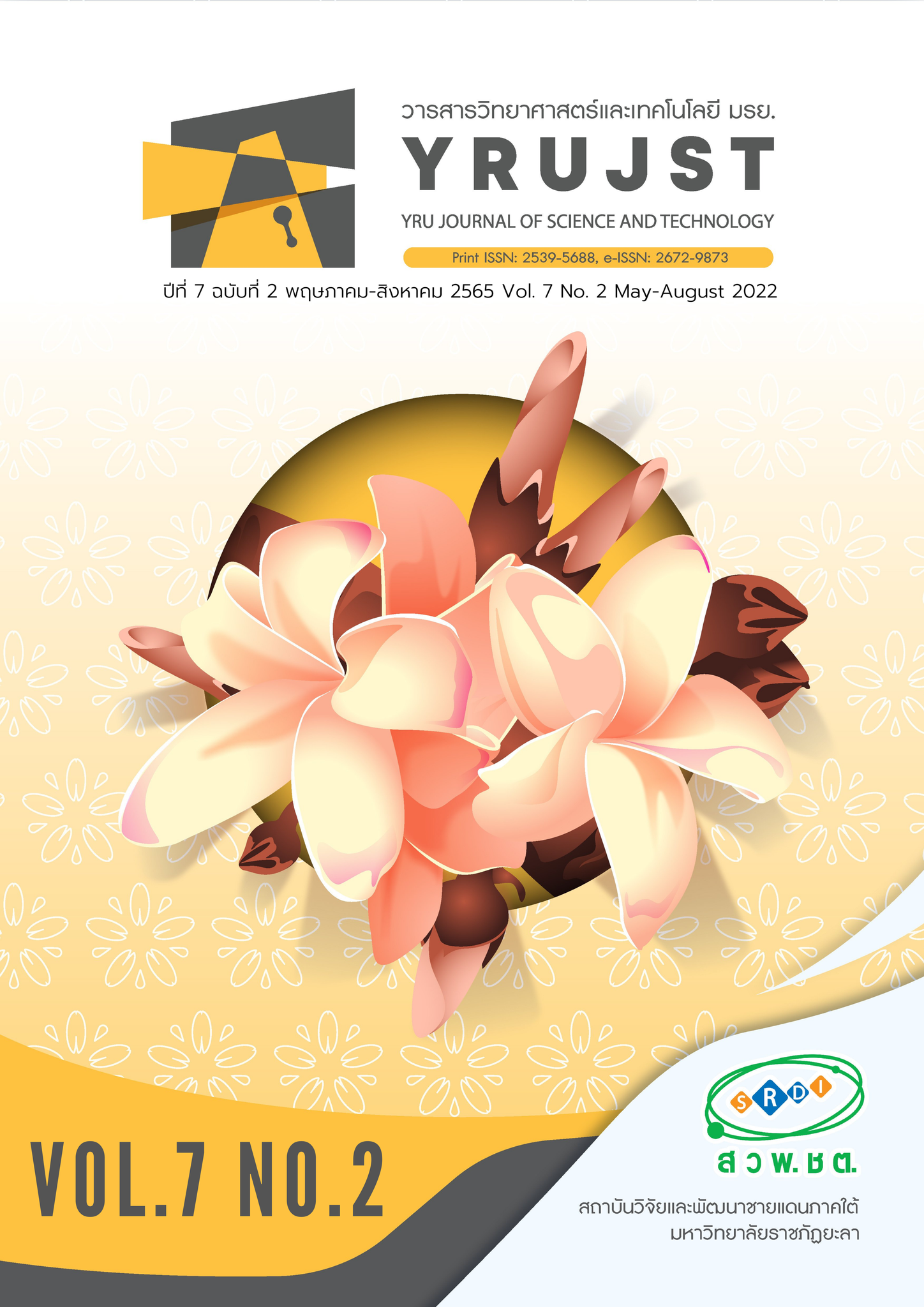Study on the Utilization of Goat Milk Acid Whey with Concentrated Alkaline Water and Sodium bicarbonate
Main Article Content
Abstract
Acid whey or sour whey, obtained from the mozzarella cheese production process, has a pH level of about 4.4-4.6, which is not edible and most of them have been left as an environmental problem. Therefore, this research was to study the content of milk composition, sensory characteristics, amino acid, vitamin A, vitamin B12 and calcium of pH-adjusted goat milk whey acid with sodium bicarbonate and concentrated alkaline water at pH levels 4.8, 5.0, 5.2, 5.4 and 5.6 was found that the amount of fat, protein, lactose and solids not fat. There were statistically different (P<0.05) and when comparing the experimental groups, the pH levels at 4.8, 5.0, 5.2, 5.4 and 5.6 were statistically different (p<0.05). interaction of these two factors, the content of fat, protein, lactose, and solids not fat of the sodium bicarbonate pH-adjusted whey acid group were higher than those adjusted with concentrated alkaline water. Sensory test of trained test subjects showed that the sodium bicarbonate-adjusted whey acid and concentrated alkaline water treatment group there was no statistically significant difference (P>0.05) but the texture there were statistically significant differences in taste (mouthfeel), taste and accept (P<0.05). trained test gave scores based on the degree of pH adjustment, with the higher the pH adjustment, the higher the taster's score accordingly. Based on the results, the panelists rated the sodium bicarbonate-adjusted whey acid and concentrated alkaline water and at the highest pH 5.6 amino acid vitamin A, vitamin B12 and calcium there was no difference and have a similar quantity
Article Details

This work is licensed under a Creative Commons Attribution-NonCommercial-NoDerivatives 4.0 International License.
บทความ ข้อมูล เนื้อหา รูปภาพ ฯลฯ ที่ได้รับการเผยแพร่ในวารสารวิทยาศาสตร์และเทคโนโลยี มรย. นี้ ถือเป็นลิขสิทธิ์ของวารสารวิทยาศาสตร์และเทคโนโลยี มรย. หากบุคคลหรือหน่วยงานใดต้องการนำทั้งหมดหรือส่วนหนึ่งส่วนใดไปเผยแพร่ต่อหรือกระทำการใดๆ จะต้องได้รับอนุญาตเป็นลายลักษณ์อักษรจากวารสารวิทยาศาสตร์และเทคโนโลยี มรย. ก่อนเท่านั้น
References
Bansal, N. & B. Bhandari. (2016). Functional milk proteins: Production and utilization - Whey-based ingredients. pp. 67-98. In: P.L.H. McSweeney & J.A. O'Mahony (eds.). Advanced Dairy Chemistry. Springer, New York
Chanakot, B., S. Chauchom and S. Nakthong. (2020). Study on optimum rennet enzyme level on mozzarella
cheese from cow milk and goat milk. Journal of Agricultural Science and Management 3(2): 81-86. (in Thai)
Çevikkalp S.A., G.B. Löker, M. Yaman & B. Amoutzopoulos. (2016). A simplified HPLC method for
determination of tryptophan in some cereals and legumes. Food Chemistry 193: 26-29.
Chen Z., Chen B., Yao S. (2006). High-performance liquid chromatography/electrospray ionization-mass
spectrometry for simultaneous determination of taurine and 10 water-soluble vitamins in multivitamin tablets. Analytica chimica acta. Vol 569, Issues 1–2, Pages 169-175
Chung E. L. T., Nayan N., Kamalludin M. H., Alghirani M. M., Jesse F. F. A., Kassim N. A., Azizi A., Reduan
M. F. H., Loh T.C., (2020). The effects of alkaline water and rainwater on the production and health performance of commercial broilers under tropical conditions. Thai J Vet Med.50 (1): 65-73.
Dannenberg, F., & H.G. Kessler .(1988). Reaction kinetics of the denaturation of whey proteins in
milk. J. Food Sci. 53: 258–263.
Hargrove, R.E. & J.A. Alford. (1974). Composition of milk products. In: fundamentals of Dairy Chemistry,
nd ed. B.H. Webb, A.H. Johnson & J.A. Alford (Editors). AVI Publish. Co., Westport, Conn., pp.58-86.
Hinrichs, J., (2001). Incorporation of whey proteins in cheese. Int. Dairy J. 11, 495–503. Jandal, J.M.,
Comparative aspects of goat and sheep milk. Small Rumin. Res. 22, 177–185.
Jompuk, C. (2012). Statistics: Experimental Design. and Data Analysis in Plant Research with “R”. 2nd ed.
Kasetsart University Press, Bangkok. 350 p. (in Thai)
Muhammad, A., Y. Durrani, M.S. Hashmi, I.M. Qazi, M. Ayub & Saifullah. (2018). Whey neutralization
with different concentration of sodium hydroxide and sodium bicarbonate. Sarhad Journal of Agriculture, 34(4): 910-916.
Poitevin E., Nicolas M., Graveleau L., Richoz J., Andrey D., & Monard F. (2019). Improvement of AOAC
Official Method 984.27 for the determination of nine nutritional elements in food products by inductively coupled plasma-atomic emission spectroscopy after microwave digestion: single-laboratory validation and ring trial. J. AOAC inter. vol. 92, NO. 5. 1484-1518
Pongsa P. & Napa T. (2021). Preparation and chemical composition of alkaline water from plant combustion ash. Malaysian Journal of Analytical Sciences, Vol 25 No 1 (2021): 129 - 137
Rahman, M., Md Nurul, I., Md. Harun, ur Rashid., & Masum, AKM., (2018). Effects of Sodium bicarbonate on milk preservation. Journal Res. Agric. Livest. Fish. Vol. 5, No. 1, April: 75-85.
Wanphaisan Pakakrong. (2019). Breast milk contains important nutrients for babies. Available:
http://healthydee.moph.go.th/view_article.php?id=484 (February 23, 2022) (in Thai)
Zhang, Y., Venkitasamy, C., Pan, Z. and Wang, W., 2013, Recent developments on umami ingredients of edible mushrooms-A review, Trends in Food Science & Technology, 33(2): 78-92.
Sae-teng, A., Laohakunjit, N. & Kerdchoechuen, O. (2018). Extraction of Glutamic Acid from Tomato. Agricultural Sci. J. 49(2) (Suppl.): 497-500
Thongtid, R. (2012). The use of sodium bicarbonate in the production of frozen shrimp. (Graduate
school Silpakorn University. P.14 (in Thai)


